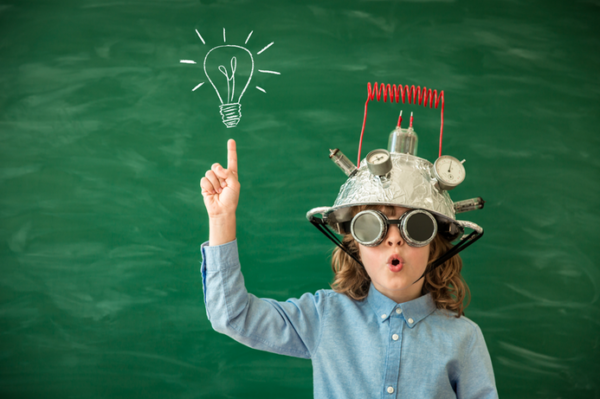Creating the Space for Creativity
August 15, 2018 in Creativity & Disruption
By Emily Winick
 Imagine someone you consider to be a ‘creative type’. What comes to mind? Is it an artist in a studio painting on an easel into the early hours of the morning? Is it an author sitting in a coffee shop writing the next biggest piece of fan fiction? Maybe you think of the whole ‘left brain, right brain’ concept and are convinced that only those who are right-brain dominant get to flex their creativity muscle. There’s good news and… well, just good news! Everyone has the capacity to improve their own sense of creativity, although it may be easier for some than others.
Imagine someone you consider to be a ‘creative type’. What comes to mind? Is it an artist in a studio painting on an easel into the early hours of the morning? Is it an author sitting in a coffee shop writing the next biggest piece of fan fiction? Maybe you think of the whole ‘left brain, right brain’ concept and are convinced that only those who are right-brain dominant get to flex their creativity muscle. There’s good news and… well, just good news! Everyone has the capacity to improve their own sense of creativity, although it may be easier for some than others.
Researchers have looked to personality traits and emotions to understand why some people are more inclined to innovate than others. A strong indicator of one’s aptitude for creativity is their degree of openness to new experiences[1], a trait which also has a positive correlation with life satisfaction and happiness. Our happiness and emotional disposition also impact our proclivity for innovation. Among entrepreneurs, those who exhibit greater levels of positive affect exhibit greater creativity, leading to innovation at the organizational level[2]. According to happiness researcher and co-Founder of GoodThink, Inc., Amy Blankson, “a positive and engaged brain is 31% more productive, three times more creative, and ten times more engaged”[3].
So, what comes first: the creativity, or the happiness? Trick question! The relationship is reciprocal; those who report a higher state of happiness are more likely to engage in creative endeavors, and those who create report higher levels of happiness after they innovate3. We wouldn’t be hard-pressed to find reasons why this is so. One of the most influential factors in one’s level of happiness is a sense of meaning. Perhaps those who create are quick to find personal meaning and fulfillment in what they produce, whether the product adds to collective knowledge, sparks a positive change, or brings joy or convenience to others. On the flip side, the minds of happy people are freer to imagine new possibilities or dream up novel solutions to our everyday problems because they aren’t bogged down by overwhelming stress or laser-focused on a point of negativity.
If creativity begets happiness and happiness begets creativity, how can we get more of both? I recently had the pleasure of attending a presentation delivered by Amy Blankson, happiness researcher and bestselling author of The Future of Happiness, at the 2018 WorkHuman conference, an event sponsored by Globoforce to share ideas about the transformative power of human-centric organizations. Blankson delivered a powerful message about how we can remain happy consumers of technology and use it to maximize our creative potential. The key lies in our ability to control the negative disruption caused by technology. Now, disruption isn’t always a bad thing (check out our blog from last week!), but in order to give ourselves the room to innovate, we have to control the kind of disruption that devours our attention and derails our productivity. So many of us find ourselves glued to our cell phones, these handheld computers that constantly ring, beep, buzz, tweet, snap… they’ve become petulant children who refuse to be ignored! But the answer isn’t to ignore them. It’s to control them with intention and mindfulness.
Blankson’s research describes a number of strategies we can use to intentionally set technology in favor of our long-term happiness. One high-impact strategy is to know when to unplug. It may not be feasible for everyone to enter a sustained technology black-out mode, but everyone can find a brief period of time to temporarily disconnect. Isn’t that what automated email replies were designed for? We can all be thankful for the creative genius who invented that. If you can’t unplug, Blankson advises that at the very least, hide your phone when you’re focusing on a task or engaging in a conversation with others. Literally removing your phone from your line of sight – not just turning it face down – will help you maintain focus, productivity, and connect with others more effectively.
To help you figure out when you need to unplug, and how dire your tech obsession may be, look at the amount of time you spend on your phone each day. Yes, there’s an app for that. (Multiple apps, actually.) Blankson states that the average person checks their phone 150 times per day. Ever find yourself wishing for more hours in the day? Put your phone in airplane mode and consider that wish granted! Blankson suggests that we examine how often we use technology to zone out rather than to tune in. To reduce the negative disruption, pay attention to when you’re using your phone to distract you versus when you’re using it as a tool for obtaining useful information.
Similar research documents other strategies for cultivating happiness and creativity at work. Among those strategies is to intentionally set things with personal meaning in your workspace. Blankson notes that when you have a positive association with the mementos that personalize your workspace, your happiness, health, and productivity improve. Another strategy that should come as no surprise is to foster a culture of social connection. Happiness researcher Shawn Achor states that social support is one of the three top predictors of long-term happiness, and not only that, but it is just as strong a predictor of your life expectancy as physical health conditions like obesity and high blood pressure! In addition to enhancing your happiness, increasing your social connection at work boosts your creative potential by supporting interpersonal collaboration.
There are no signs of technological advancements slowing down any time soon. With it becoming an ever-growing influence in our lives, staying conscious of how, when, and why we interact with technology will keep us happier and free up the space our minds need to drift into the place where our innate creativity lives.
Now go forth, and create!
About the Author: When Emily’s not reading proposals or in the office with her fun coworkers, her favorite place to be is on the beach sipping a cool drink from a pineapple. Actually, any fruit will do!

References:
[1]Feist, G. (1998). A meta-analysis of personality in scientific and artistic creativity. Personality and Social Psychology Review, 2(4), 290-309.
[2]Baron, R.A., & Tang, J. (2011). The role of entrepreneurs in firm-level innovation: Joint effects of positive affect, creativity, and environmental dynamism. Journal of Business Venturing, 26(1), 49-60.
[3]Blankson, A. (2017). The future of happiness: Five modern strategies for balancing productivity and well-being in the digital era. BenBella Books, Inc. Dallas, TX.